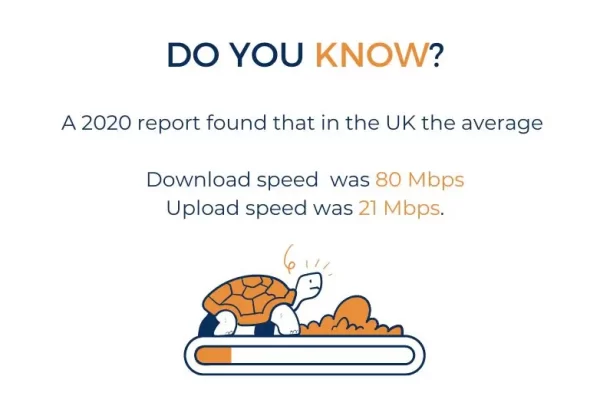
In today’s digital age, a fast and reliable Internet connection is crucial for business. It must also keep pace with the increased data traffic generated by online applications.
If your broadband is slow, accessing and using online resources will be slow. So if you are still using copper based broadband services like ADSL and FTTC, then it could be costing you thousands of Pounds a year in lost time and customer goodwill. This is where fibre broadband comes in.
In a recent article we talked about why a business should invest in fibre broadband and how to choose it (Read more here). In this article, we will explore how fibre broadband works and what fibre services are available in the UK.
What Is Fibre Broadband?
Fibre broadband is a high-speed Internet service that uses fibre optic cables to send data. This is different from traditional copper based broadband services which use electrical signals. This means that fibre broadband gives you a faster and more reliable connection compared to the copper based broadband services such as ADSL.
The best part? Fibre broadband, commonly known as Fibre To The Premises (FTTP) can deliver speeds of up to 1 gigabit per second. This is lighting fast, perfect for video conferencing, and transferring large files to and from the cloud. Fibre cables are unaffected by distance and interference, so your fibre broadband connection is more stable and consistent. No more buffering or dropped calls.
So, if you are looking for a faster and more reliable Internet connection, full fibre broadband is the answer.
GET IN TOUCH!
We want to hear about your challenges. Talk to us! Our consultants can audit your systems, plan changes, implement improvements and support your people.
How Does Fibre Broadband Work?
Instead of using regular copper cables, fibre broadband uses special fibre optic cables that send data as pulses of light through thin glass or plastic strands. This makes data transmission fast and means that you receive your data back quickly and more efficiently.
Full fibre broadband also known as FTTP delivers
- Faster download and upload speeds. Usually symmetrical speeds, meaning the same upload as download speed, and
- Lower latency which means less lag or delay
So, if you want to experience the magic of a stable, fibre broadband for yourself, it might be time to upgrade your connection!
The Different Types of Fibre Broadband
Today there are two types of fibre broadband available in the UK.
- Fibre to the Cabinet (FTTC)
This is the service that is most widely available today but is not ‘full fibre.’ Fibre to the Cabinet (FTTC) is a fibre connection up until it reaches your local street cabinet. The ‘last mile’ where it connects to your premises is made by using copper cable. FTTC can give you faster speeds than ADSL broadband, but it is reliant on the copper line into your premises. For this reason, this service will cease to be available at the end of 2025 when Openreach close down the existing copper network.
- Fibre to the Premises (FTTP), also referred to as Fibre to the Home (FTTH) for residential users.
FTTP broadband is ‘full fibre.’ Data is transmitted end-to-end over fibre optic cables. This includes the ‘last mile’ to your premises. This means a faster and more reliable connection. This is the type of connection we will all have in the future, though some can access it now.
A leased line is a dedicated FTTP service. This means that you do not share the line with anyone else. Businesses use leased lines for critical and secure data transmission. You will pay a premium for a leased line but will have a guaranteed fixed speed with no contention, and a faster Service Level Agreement (SLA) should anything ever go wrong.
Availability of Fibre Broadband in the UK
The UK government is committed to expanding fibre broadband access to 85% of the population by 2025. Many areas already have full fibre connectivity. So, if you are tired of slow Internet speeds, unreliable connections and would like to safeguard your business, now is the time to upgrade to fibre broadband, ahead of the December 2025 deadline when copper-based services will cease (Read more here).
Full fibre broadband will give you a fast, stable Internet connection and boost your business. Contact us to see if you can take advantage of full fibre broadband now!
GET IN TOUCH!
We want to hear about your challenges. Talk to us! Our consultants can audit your systems, plan changes, implement improvements and support your people.
Stay Up to Date With Us
Subscribe to Our Newsletter
Follow Us
Click below to explore our feeds!
Services
IT Consultancy
Communications Services
Service Levels
Resources
Terms & Conditions
Privacy Policy
Mobile Roaming
Quick Links
Success Stories
Contact US
About US
Blog
GET IN TOUCH!
We want to hear about your challenges. Talk to us! Our consultants can audit your systems, plan changes, implement improvements and support your people.
Call us on 0118 920 9420
Email us [email protected]
GET YOUR FREE IT AUDIT!

To give you confidence in our service, get to know us and how we work, contact us for your Free IT Audit.
The IT Audit
- Provides us with the information to assess the status of your systems.
- Identifies any vulnerabilities and potential concerns.
- Shows you how we manage your systems and report back.






